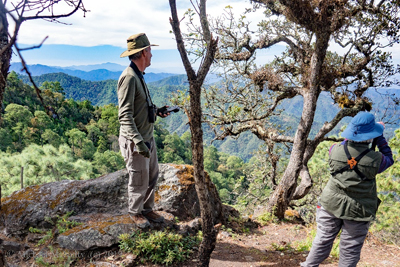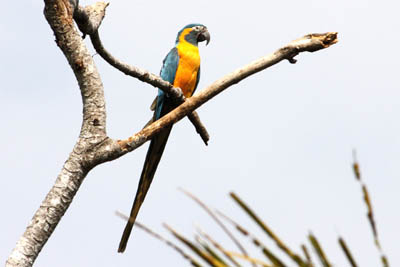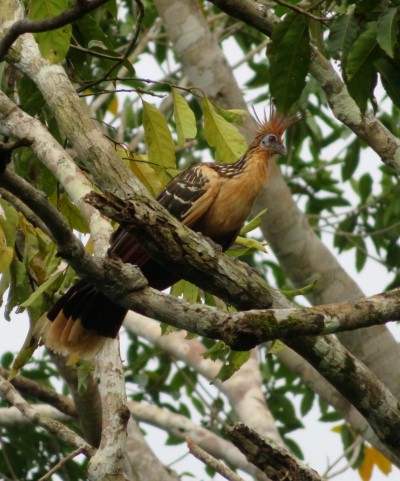|
We would love to hear about your VENT traveler experiences! For more information, please click on News Briefs. Read more in the June 9, 2020 article to learn how you can submit your written document and one image for your experience. |

December 8, 2021 On the Trail with Brian Patrick Gibbons by Michael McNulty In a small circle, eight of us waited in perfect silence and near total darkness while Brian played the sound of a Mottled Owl: to my ears, a generic made-for-Hollywood whoo-whoo. Again, one minute later. Again, one minute later. The stakeout became an exercise in meditation: listening intently—at this stage—for nothing. The silence of the dry forest of western Mexico was complete, and became a more clearly perfect silence the longer we waited. The profound peacefulness of this setting made me hope that the owl would take its sweet time; and so it did. But finally, Brian played an alternate call resembling a cat whose tail was being pulled. Seconds later from directly above us came the response: “WHO?!?“. Brian’s flashlight came on, and the Mottled Owl’s great round eyes gazed down at us, invoking Lewis Carroll. We stared. It stared. Time passed. It flew. We went to breakfast. Our bird whisperer on the Western Mexico trip was Brian Gibbons. Brian fell into birding young, in his teens, and he never seriously wanted to do anything else. Shortly after Victor Emanuel founded his birding company (ventbird.com), he initiated an annual youth birding camp for teens. Brian did that more than twenty-five years ago and has been a protégé of Mr. Emanuel ever since. He is broadly responsible for ornithological taxonomy within VENT, tracking the incessant lumping and splitting of species, ensuring that the stream of reports coming from the company’s 30+ guides are scientifically up to date. Like all of the guides working for VENT, Brian has an uncanny talent for knowing precisely what birds are in front of him, more or less instantly. There was a moment when we were standing on a southwest facing canyon late in the day, looking for (and finding, always finding, whatever the bird) the Aztec Thrush, when a ‘mixed flock’ of small birds flew across the canyon from left to right in front of the sun. Songbirds like to migrate in packs; no doubt it’s safer, as they can warn one another of dangers. But it always seems to me, watching them, that danger or no danger, they are just extremely sociable creatures. Brian has many obligations as bird guide, but Job One is always to identify the birds you see in real time. He raised his arm, pointing, and realizing what was happening allowed a note of urgency and excitement to creep into his voice. As they streamed by, he said, “there’s a Blue Grosbeak and a Hepatic Tanager and a Black-throated Gray and a MacGillivray’s Warbler and a Slate-throated Redstart and a Chestnut-sided Shrike-Vireo, and an Audubon’s Oriole and a Rufous-backed Robin and a Brown-backed Solitaire…” Importantly, he did this without being able to see any colors; we were looking straight into the sun and the birds were all in silhouette, and he did this in less time than it took you to read the previous sentence. (The birds I included are only those I can now remember.) Then he said, “That was pretty good.” If one hears a pianist play flawlessly in “La Campanella” by Lizst, one can safely assume—regardless of how gifted or talented that pianist may be—that this musician has spent thousands upon thousands of hours sitting in front of a piano. Similarly, it boggles the mind to imagine how much time Brian (and all the VENT guides) have spent peering into the depths of high mountain forests to reach such a level of sufficiency. But there’s something else. Brian travels with the recordings of five thousand bird calls, and so as far as I can tell, he can recognize all of them without hesitation. That suggests a lot of homework, no? And still, knowing these five thousand languages would not be of much benefit if your hearing is less than adequate. And this is where my powers of description are going to fail me. Brian’s aural capacities are hard to comprehend. Walking along a dark forested road he will say, “there’s a Golden-Browed Warbler,” pointing to where he has heard a low bird call. None of us has heard it, nor have any of us seen it. Early on, I thought how easy it would be for him to be having us on; that this could be a fantastic practical joke. Obviously, we couldn’t prove him wrong, as we didn’t know what he was talking about. He could have been inventing birds out of thin air. But then I saw that with patience and an uncanny knowledge of each bird’s habits and habitats, Brian could seduce the bird he heard out of hiding. There!” And thus would appear…the Golden-browed Warbler. Or the Rusty-crowned Ground-Sparrow. Or the Rosy Thrush-Tanager. Or the Orange-billed Nightingale-Thrush. All identified by ear before they came into view. (We saw nearly 250 species that week.) But wait, there’s more. Knowing the multitudinous habitats in the Sierra Madre Occidental, knowing the birds that live there, and knowing the foraging behavior of all these beauties, Brian would tell you what bird you should expect to see after hearing some scratching in the leaf litter under a wall of shrubbery. “These will be Rosy Thrush-Tanagers,” he will say, pointing to where he has heard some dry leaves being overturned. At this juncture I could no longer understand how this capacity for hearing sounds in the environment could be merely human. The setting is an enormous mountainside, full of life and pine trees sighing in the breeze and insects whirring and a squad of birders shuffling along. I came to think of Brian as someone with superpowers. Believe me when I say that the vast majority of humanity would not have had a hope of picking up the sound of a leaf being overturned, much less a chance of discriminating that sound from the infinity of other sounds being generated at that time in those mountains. Nor could they have told you (I mean, really?!) to expect a Rosy Thrush-Tanager. Brian Gibbons, one of the best birders in the world. Photo: Brian Gibbons, on the trail in the Sierra Madre Occidental © M. McNulty, 2018. |
 November 23, 2020 Looking for Judy in Papua New Guinea By Tom Taylor Or that’s how I reacted, anyway, as have lots of others I’ve traveled with. But my wife Judy? She was the principal of an Austin elementary school in a challenging community, and dealt with all sorts of folks every day. People do not scare her; quite the contrary. On that same 2012 trip, we were at the airport at Mount Hagen, Papua New Guinea—a dirty, crowded, disorganized place, in a city not renowned for friendliness. We managed to check in for our flight, then huddled as a group while hawkers offered skulls of hornbills, assorted other animal parts, and unidentifiable snacks. Then, suddenly, I couldn’t find Judy… …and then I did, and I will never forget the scene. She was sitting on the floor against a wall, surrounded by a group of four Papuan women and girls, laughing, gesticulating, communicating in some universal language. The rest of us were wary and subdued; she was having a grand time! |
|
|
 September 10, 2020
See 'um and Save 'um
Bolivar + Bolivia + Blue-throated Macaw
September 10, 2020
See 'um and Save 'um
Bolivar + Bolivia + Blue-throated Macaw
This story begins near Victor's house on the Bolivar Peninsula and ends in Bolivia, both places named for Simon Bolivar—seems fitting. We were attending a bird outing led by Victor when he was on the American Bird Conservancy (ABC) Board of Directors, in the spring of 2007. Also on the trip, in addition to a few other participants, were Dr. George Fenwick, then President of ABC, and Mike Parr, then Director of Conservation. It was a wonderful spring migration outing on the beach, at High Island, at Anahuac National Wildlife Refuge, and at numerous other spots. Discussion while not birding was about bird conservation, focused on habitat preservation for endangered species. ABC had devised the Alliance for Zero Extinction (AZE) to focus on specific birds at risk and their habitats for priority conservation. Three months later we were on a VENT tour to Bolivia led by Steve Hilty, guide extraordinaire, to Noel Kempff Mercado National Park and the area around Trinidad in the Beni region of Bolivia, all very birdy. This was a trip we had wanted to go on for years. In Santa Cruz, we climbed into our three small planes, and the missionary pilot flew us first to Mira Flores in the north part of the park for a few days, and then to a grass strip at Los Fieros in the south, where we spent another few days. After a few days birding, we boarded our planes for the trip back to Trinidad, arriving just before a terrific storm with high winds and rain. That evening we celebrated the 82nd birthday of trip participant Dr. Doug James, one of Steve Hilty's professors at the University of Arkansas. The following day's agenda was to drive about 30 miles south of Trinidad to find the rare Blue-throated Macaw. We found them on a run-down cattle operation, where we saw and photographed about half a dozen of these magnificent macaws, one of the highlights of the tour. Patricia was profoundly affected after seeing these birds in such bad habitat. And there the idea was conceived as to how to protect these amazing birds. A connection between ABC and AZE was at the forefront of our ideas. After arriving home, we called George Fenwick to inquire about the possibility of doing something to ensure that the Blue-throated Macaw did not go extinct. ABC subsequently sent someone to Bolivia to investigate and discovered that Armonia, a Bolivian bird conservation NGO, had been working with people around Trinidad to stop the caged bird trade in Blue-throated Macaws, trying to find a substitute for the use of their tail feathers in headdresses used in local ceremonies and speaking with children about the need to conserve these birds—their birds. Armonia had a lot of knowledge about where the macaws were and their biology, and was ready to find a sanctuary for them. There were two populations of the macaws: about 20 birds in the north, they thought, and very isolated, and a southern population of 35 birds. Armonia soon found a suitable site for a preserve, if money could be found to buy a ranch in the Llanos de Moxos, where the area is flooded about half the year, similar and not too far from the Brazilian Pantanal. Soon thereafter, ABC raised the funds for purchase of a 9,000-ha ranch in the Beni, 175 km northwest of Trinidad, and the Barba Azul Nature Preserve was founded. The bird count is 320 species, and it increases each year. The mammal count is 27 species. Today Barba Azul is 27,180 acres with 4 cabins and a dining facility, a field station for the research students who come each year. The Blue-throats are now about 400 and increasing. Also, there is now a second preserve about 45 km south of Trinidad for the southern population. Thank you Victor, VENT, Steve Hilty, Armonia, ABC, and many others. See 'um and Save 'um.
|

July 10, 2020
Hoatzins on the Amazon River Cruise
By Sherry Rhodes, Sarasota, Florida
My husband and I retired and moved to Florida in May 2019. It was a hectic time with our daughter graduating from college, selling our home, and moving to a new state. Shortly after moving into our new place, we received a postcard mailing from VENT about the Amazon River Cruise scheduled for February 2020. I had always wanted to do a trip like that, but with all the upheaval of moving and selling our home, I thought it just wasn’t the right time. However, I kept that large, colorful mailing on my bedside table and found myself looking at it multiple times a day. My husband noticed this, and after a couple of weeks, he said, “I think we should go.” I was so excited, and we immediately signed up and began to anticipate this wonderful experience. Another bonus was that one of the guides for the trip was Andy Whittaker, who had guided another excellent VENT adventure we took in Scotland in 2018. One bird that I really wanted to see on this trip was the Hoatzin. This is just such an unusual and exotic bird, and I thought seeing a bird like that in a setting like the Amazon would be an incredible memory. When the day came that we arrived in the area where the Hoatzins live, we all got into our skiffs in the late afternoon and approached a very quiet and placid lagoon-like lake off the river. The light was incredible as the guides cut the motors and we glided toward the tree where the Hoatzins liked to congregate. We all stayed very quiet as we approached the tree…and there they were! Several of these unique-looking birds were perched in full view, and we were able to view them for a prolonged period. I will never forget that sight, surrounded by the sounds of the Amazon rainforest and the water lapping the shore. I’m even more glad now that we went ahead and took that trip, since it is the last trip we took before travel shut down due to the pandemic. My new mantra is: Take trips when you have the chance, because we never know when we’ll get another opportunity. VENT’s next Amazon River Cruise will operate January 27-February 5, 2022. |
| ALL TOURS | NEW TOURS | SPECIAL OFFERS | CRUISES |